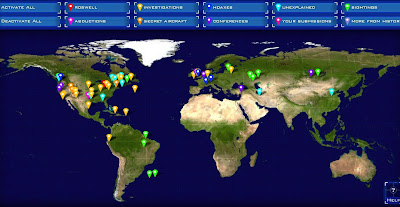Intraterrestrials: Mars Life May Hide Deep Below
APR 8, 2013 01:11 PM ET // BY RAY VILLARD
Almost every month we see news dispatches from Mars, where the nuclear-powered rover Curiosity finds water-bearing minerals in rocks and other circumstantial clues that the Red Planet could have once supported life.
But in terms of finding direct evidence of past or present Martians, the rover barely scratches the surface, says geochemist Jan Amend of the University of Southern California. Amend spoke at the Space Telescope Science Institute in Baltimore, Md., on April 5. (You can watch a video of the research presentation here.)
PHOTOS: Curiosity Drills Hole Into Mars Rock
Curiosity’s drill can, at best, penetrate a few inches into the crust of Mars rock. Amend’s guess is that life has buried itself deep into the Martian crust a half-mile or more beneath the withering orange surface. Even if the ancient streams or lakes on Mars evaporated, there could very likely still be substantial reservoirs of water, in either liquid or frozen form, in the subsurface.
Amend’s lab at the University of Southern California studies microbial chemistry in ocean hydrothermal vents. Recently, NASA funded his astrobiology team to do experiments searching for life deep underground as a guide to hunting for extraterrestrial life on neighboring planets and moons.
The project also includes collaborating scientists from Caltech, JPL, Japan’s Agency for Marine-Earth Science and Technology, and several other U.S. research institutions, including Arizona State University and Rensselaer Polytechnic Institute.
It’s estimated that one-third of Earth’s carbon biomass is locked away beneath the crust. The team is going far beneath the sedimentation at the bottom of Earth’s oceans and into porous rock to look for life. Destinations are the Mid-Atlantic ocean floor — more than two and a half miles below the water’s surface. More Mars-like conditions call for borrowing a half mile into deep mine shafts in locations in the continental United States, including, ironically, Death Valley in California.
This region beneath Earth’s deserts is just about as alien as Mars — but much more reachable. It is completely unknown how much life or what kinds of new life forms are down there in a pitch-black, rocky, high-pressure, low-nutrient environment. “We are going to biotic fringe to look for new organisms,” says Amend.
Top 10 Places To Find Alien Life
The idea of an underground biosphere was popularized in Jules Verne’s 1864 novel, “A Journey to the Center of the Earth.” Perhaps inspired by Charles Darwin’s emerging theory of evolution, Verne describes his geologist explorers finding Earth’s interior alive with prehistoric plants and animals. Now, Earth’s subsurface frontier will help scientists test ways to look for subterranean life on other worlds.
Over the next five years, Amend will drop eight-foot long torpedo-shaped biology probes, called SEALs (Subsurface Explorer for Assessment of Life), down boreholes and mine shafts. He will try to catch a glimpse of any organisms that dwell thousands of feet below the surface. They’ve been dubbed “intraterrestrials.”
New life detection technologies being developed for the exploration of the deep biosphere could be precursors to what might be dispatched to other planets and moons someday. This includes a miniaturized ultraviolet microscope to detect bioluminescence. The probes will look for microbes, collect data on understanding them, and try to grow them in situ (as was done on the Viking Mars lander experiments in 1976). Other samples will be brought back to labs for analysis. The ultimate goal is to learn more about the range of conditions that support life on our planet.
Among other microorganisms, his research so far has foundFirmicutes, spore-forming bacteria that survive in extreme environments. Most intriguing of all is the microbe Desulforudis Audaxviator (pictured here) that dwells nearly two miles down. This bacteria is one of very few known to survive without sunlight, oxygen or organic compounds. It has existed for millions of years on chemical food sources that are derived from the radioactive decay of minerals.
“This organism has had to figure out everything on its own,” says Amend. “It splits water into hydrogen and oxygen for metabolism.”
The bacteria is a loner at these depths; its DNA makeup is 99 percent of just one species. It seems like the bug would feel right at home on Mars.
NEWS: Next Mars Lander Will Drill into the Red Planet
Getting to such deep dwellers on Mars would require that a drilling rig be transported to the Red Planet. This could be a prime activity accompanying a future manned mission to Mars.
In the absence of human spaceflight, perhaps someday a brawny, artificially intelligent, robotic deep-drill assembly could be soft-landed, using some of the science instrumentation developed by Amend’s team.
Unlike on Earth, a Mars drill would not be able to go through mud, water or probably even gas pressure to carry the cuttings away from the drilling bit. Engineers will need to develop new methods for fluidless drilling. The Mars drill will need an effective means of keeping the hole open without the use of heavy steel casings.
A creative alternative is to develop a robotic mole that burrows deep into the ground by pulverizing rock and soil. You might name it Digger after Fox-TV’s NASCAR cartoon gopher.
In 2007, NASA discovered what looks like skylight entrances into subterranean caverns on Mars (pictured right). They are located on the flanks of the volcano Arsia Mons, which is 30 times the volume of Mauna Loa in Hawaii, the largest volcano on the Earth. These collapsed pits might offer a tunnel into subsurface voids. This could open a passageway to a 21st century spinoff of the Verne novel: “Journey to the Center of Mars.”
Image credits: NASA, Southam, G. (University of Queensland); Wanger, G. (J. Craig Venter Institute)
terça-feira, 9 de abril de 2013
Discovery News - Intraterrestrials: Mars Life May Hide Deep Below
Observador. Tecnologia do Blogger.




































0 comentários:
Postar um comentário
Escreva, sinta-se à vontade para expor suas idéias.